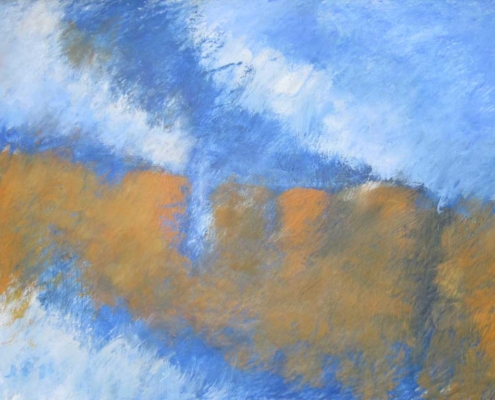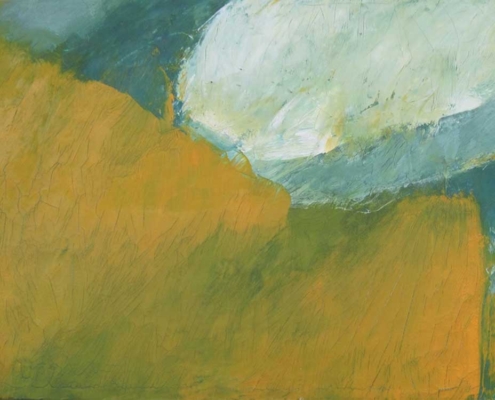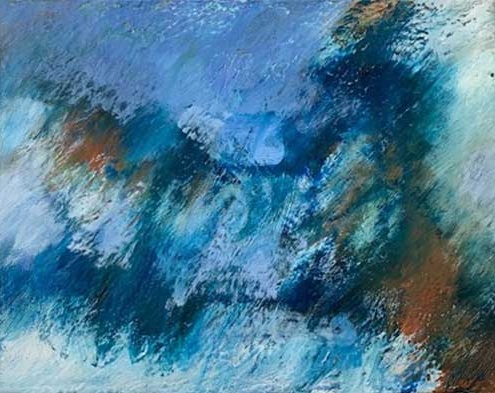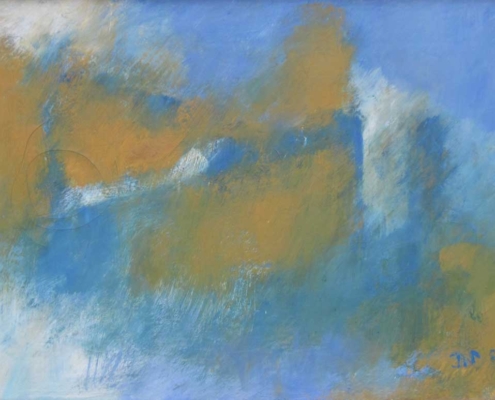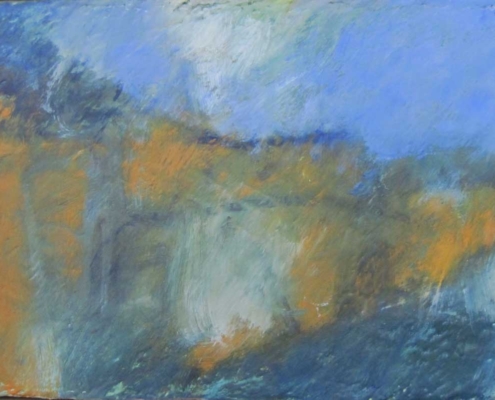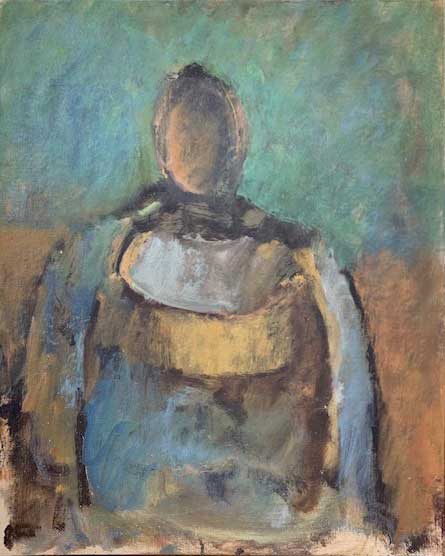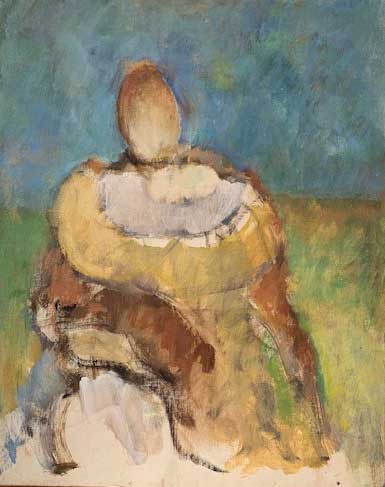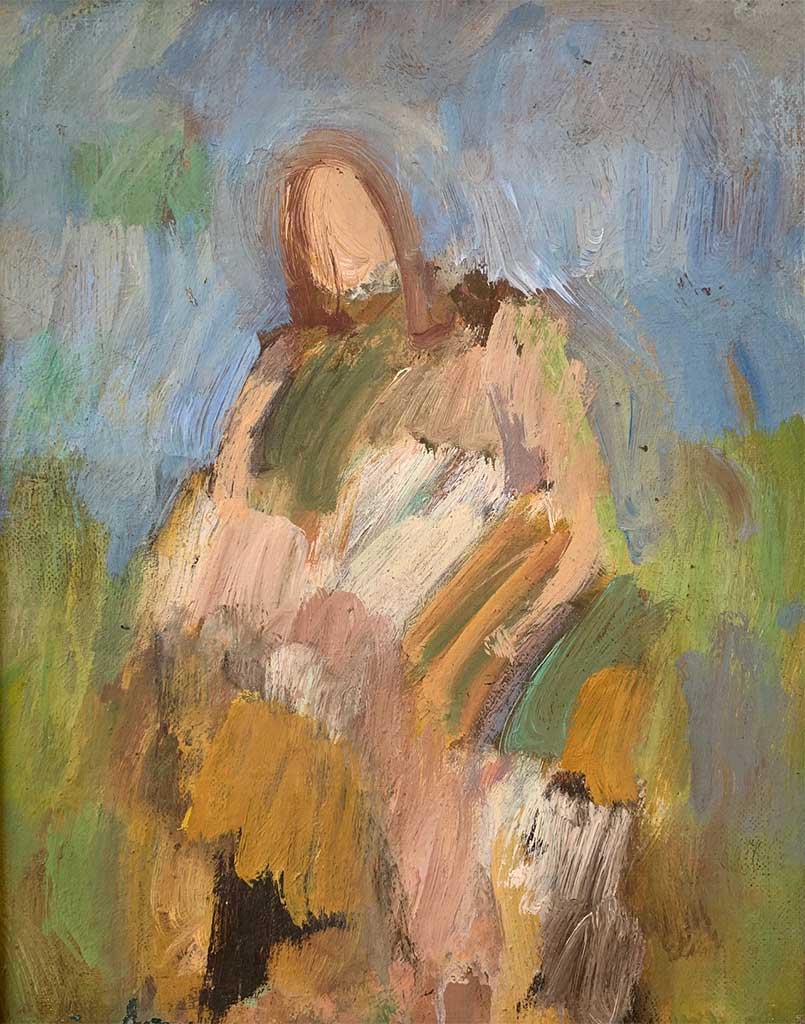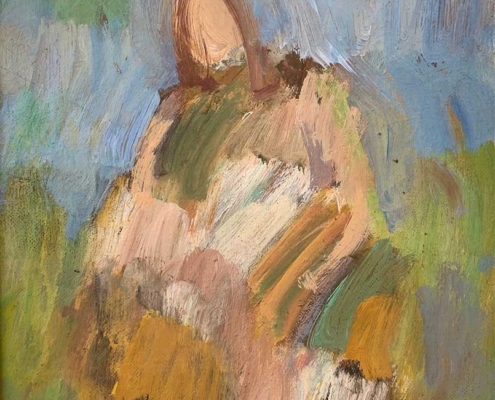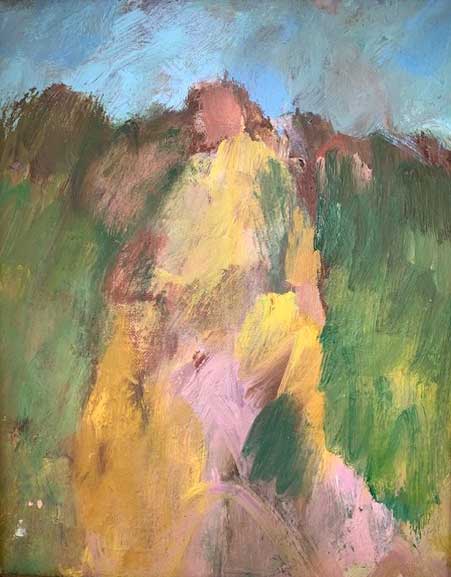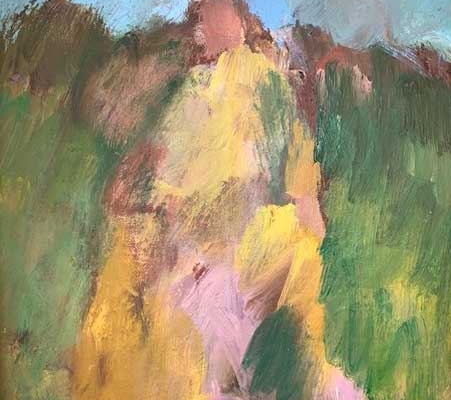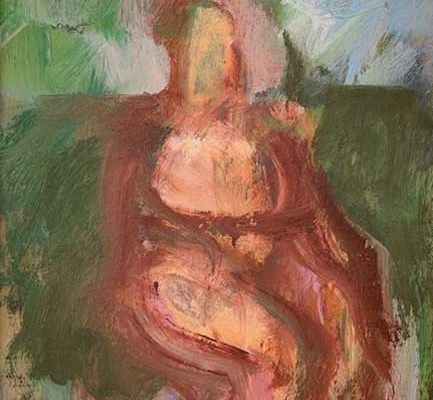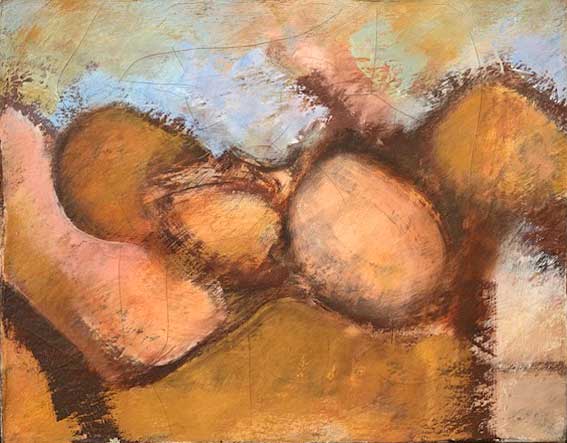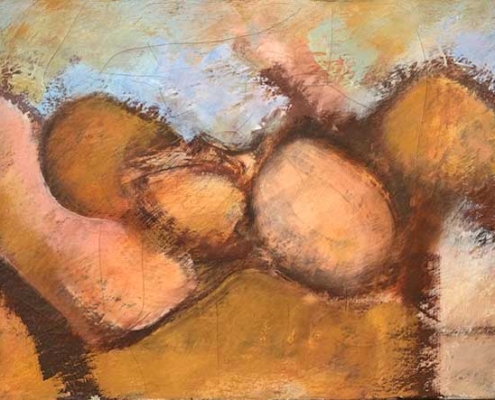“His paintings are ambiguous between landscape and still life and hence between abstraction and representation. But even when these identities are clear, there will be ambiguities of form and space: a certain shape may be a hill, sloped in Euclidean space, or a meadow tipped up in Cubist space.… Sawin treats boundaries as the locus of tensions so extreme that they induce vibrations all across the visual field. So the objects — apples, dishes, bottles, if still lifes; meadows, trees, suns, if landscapes — are not located in space but create spaces of a kind possible only in paintings: they serve… as condensations of space, …. an almost viscous medium.
– Arthur Danto, The Nation, October 18, 1986
“His paintings are ambiguous between landscape and still life and hence between abstraction and representation. But even when these identities are clear, there will be ambiguities of form and space: a certain shape may be a hill, sloped in Euclidean space, or a meadow tipped up in Cubist space.… Sawin treats boundaries as the locus of tensions so extreme that they induce vibrations all across the visual field. So the objects — apples, dishes, bottles, if still lifes; meadows, trees, suns, if landscapes — are not located in space but create spaces of a kind possible only in paintings: they serve… as condensations of space, …. an almost viscous medium.
– Arthur Danto, The Nation, October 18, 1986
“There is then this increase in subtlety and allusion, of qualified commitment to form and hue and outline together with a readiness to change direction, so that each painting, more and more, becomes a series of probes and retractions…where he offers a furious yellow the opportunity to be a meadow as it offers him the vision of a tree or house drenched in an impossible sunlight, and artist and painting settle for something which is all three, somehow, and something else besides. …I cannot walk into a room where a painting by David Sawin hangs without being drawn into it, as Swann, upon hearing the phrase of Vinteuil, would become transfixed. That phrase, Proust says, “suggested to him a whole world of inexpressible delights, of whose existence, before hearing it, he had never dreamed, into which he felt that nothing else could initiate him.” And something like this is true of Sawin’s work, which awakens us, always, to the true forgotten magic of art.
– Arthur Danto, Encounters and Reflections: Art in the Historical Present, Farrar Strauss Giroux
“There is then this increase in subtlety and allusion, of qualified commitment to form and hue and outline together with a readiness to change direction, so that each painting, more and more, becomes a series of probes and retractions…where he offers a furious yellow the opportunity to be a meadow as it offers him the vision of a tree or house drenched in an impossible sunlight, and artist and painting settle for something which is all three, somehow, and something else besides. …I cannot walk into a room where a painting by David Sawin hangs without being drawn into it, as Swann, upon hearing the phrase of Vinteuil, would become transfixed. That phrase, Proust says, “suggested to him a whole world of inexpressible delights, of whose existence, before hearing it, he had never dreamed, into which he felt that nothing else could initiate him.” And something like this is true of Sawin’s work, which awakens us, always, to the true forgotten magic of art.
– Arthur Danto, Encounters and Reflections: Art in the Historical Present, Farrar Strauss Giroux
“Sawin paints and repaints slowly, working on a relatively small scale….All my stylistic comparisons to other artists only emphasize how unique his work is, for Sawin, the most self-sufficient important painter I have ever met, has a rare gift: absolute single-mindedness. His depicted things merge even as they merge from his brushwork, which is everywhere full of life. Whatever he paints, he transforms, creating a world in which, unexpectedly, color finds color in harmony.”
– David Carrier, The Aesthete in the City, Penn State University Press
Figures and Still Lifes
“Sawin paints and repaints slowly, working on a relatively small scale….All my stylistic comparisons to other artists only emphasize how unique his work is, for Sawin, the most self-sufficient important painter I have ever met, has a rare gift: absolute single-mindedness. His depicted things merge even as they merge from his brushwork, which is everywhere full of life. Whatever he paints, he transforms, creating a world in which, unexpectedly, color finds color in harmony.”
– David Carrier, The Aesthete in the City, Penn State University Press
Figures and Still Lifes
“David Sawin shows paintings that, whether still life or landscape, are full of the same weather: the fresh dampness following rain.”
– Fairfield Porter, Arts Magazine, April, 1958
“David Sawin shows paintings that, whether still life or landscape, are full of the same weather: the fresh dampness following rain.”
– Fairfield Porter, Arts Magazine, April, 1958
Following is one of Sawin’s letters to critic Arthur Danto, shedding some light on their mutually respectful relationship, which was close enough to allow for polite disagreement.
Dear Arthur,
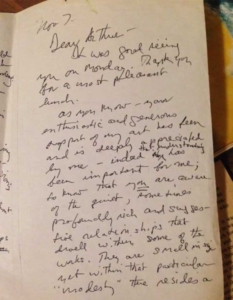 It was good seeing you on Monday. Thank you for a most pleasant lunch.
It was good seeing you on Monday. Thank you for a most pleasant lunch.
As you know, your enthusiastic and generous support of my art has been and is deeply appreciated by me – indeed that understanding has been important for me; to know that you are aware of the quiet, sometimes profoundly rich and suggestive relationships that dwell within some of the works. They are small is size yet within that particular “modesty” there resides a bright fire. It seems to me therefore that the word “unpretentious” would have been more appropriate than your choice “unassuming.”
You have mentioned to me that you have admired the “worked over” surfaces which in a sense reveal the roving voyage to completion – including the frequent “running aground ”- efforts to dislodge, to set new directions – all in one work. Each painting reveals, quite without scheme or program, the process of its evolution. If you agree to this perhaps clumsy characterization, why did you write that I am/they are “too little reflective on their own processes?”
Arthur, I am painfully aware of the processes.
The word “great” of course varies with the contexts. I agree with your general conclusion (assertion) that there cannot be great painting anymore. I assume you mean “great” in the sense of art history “great” – pivotal figures – Cezanne, Goya, Caravaggio, etc. But within the theories in which they work there are Corots who broke no new ground: but the best of whose works are rich and unique (the early ones) and profoundly personal.
I am not arrogant or especially vain but within the limits of whatever tradition I am working, I’d not trade places with any other artist. The best of my paintings are incomparable.
My best to you and Barbara. I look forward to hearing from you.
Warmly,
David
Following is one of Sawin’s letters to critic Arthur Danto, shedding some light on their mutually respectful relationship, which was close enough to allow for polite disagreement.
Dear Arthur,
 It was good seeing you on Monday. Thank you for a most pleasant lunch.
It was good seeing you on Monday. Thank you for a most pleasant lunch.
As you know, your enthusiastic and generous support of my art has been and is deeply appreciated by me – indeed that understanding has been important for me; to know that you are aware of the quiet, sometimes profoundly rich and suggestive relationships that dwell within some of the works. They are small is size yet within that particular “modesty” there resides a bright fire. It seems to me therefore that the word “unpretentious” would have been more appropriate than your choice “unassuming.”
You have mentioned to me that you have admired the “worked over” surfaces which in a sense reveal the roving voyage to completion – including the frequent “running aground ”- efforts to dislodge, to set new directions – all in one work. Each painting reveals, quite without scheme or program, the process of its evolution. If you agree to this perhaps clumsy characterization, why did you write that I am/they are “too little reflective on their own processes?”
Arthur, I am painfully aware of the processes.
The word “great” of course varies with the contexts. I agree with your general conclusion (assertion) that there cannot be great painting anymore. I assume you mean “great” in the sense of art history “great” – pivotal figures – Cezanne, Goya, Caravaggio, etc. But within the theories in which they work there are Corots who broke no new ground: but the best of whose works are rich and unique (the early ones) and profoundly personal.
I am not arrogant or especially vain but within the limits of whatever tradition I am working, I’d not trade places with any other artist. The best of my paintings are incomparable.
My best to you and Barbara. I look forward to hearing from you.
Warmly,
David

